COVID-19 in Memes: The Adaptive Response of Societies to the Pandemic?
Abstract
:1. Introduction
2. Materials and Methods
2.1. Study Organization and Eligibility Criteria
2.2. Comparing the Content of Coronavirus Memes and Random Memes
2.3. Statistical Data Analyses
2.3.1. Testing Associations among Variables
2.3.2. Meme Image Content Analysis
2.3.3. Text Analysis and Sentiment Analysis
2.3.4. Funniness of Memes
3. Results
3.1. Availability of Coronavirus Memes and Their Popularity
3.2. The Differences in the Interest in Coronavirus Memes among Countries
3.3. Meme Contents
4. Discussion
Study Limitations
5. Conclusions
Supplementary Materials
Author Contributions
Funding
Institutional Review Board Statement
Informed Consent Statement
Data Availability Statement
Acknowledgments
Conflicts of Interest
References
- Chakraborty, I.; Maity, P. COVID-19 outbreak: Migration, effects on society, global environment and prevention. Sci. Total Environ. 2020, 728, 138882. [Google Scholar] [CrossRef] [PubMed]
- Skórka, P.; Grzywacz, B.; Moroń, D.; Lenda, M. The macroecology of the COVID-19 pandemic in the Anthropocene. PLoS ONE 2020, 15, e0236856. [Google Scholar] [CrossRef] [PubMed]
- Perugini, C.; Vladisavljević, M. Social stability challenged by COVID-19: Pandemics, inequality and policy responses. J. Policy Model. 2021, 43, 146–160. [Google Scholar] [CrossRef] [PubMed]
- Silver, R.C. Surviving the trauma of COVID-19. Science 2020, 369, 11. [Google Scholar] [CrossRef]
- American Psychological Association. Stress in AmericaTM 2020: Stress in the time of COVID-19. 2020. Available online: https://www.apa.org/news/press/releases/stress/2020/stress-in-america-covid.pdf (accessed on 12 September 2022).
- Xiong, J.; Lipsitz, O.; Nasri, F.; Lui, L.M.W.; Gill, H.; Phan, L.; Chen-Li, D.; Iacobucci, M.; Ho, R.; Majeed, A.; et al. Impact of COVID-19 pandemic on mental health in the general population: A systematic review. J. Affect. Disord. 2020, 277, 55–64. [Google Scholar] [CrossRef] [PubMed]
- Fernandes, N. Economic Effects of Coronavirus Outbreak (COVID-19) on the World Economy; IESE Business School Working Paper, No. WP-1240-E; University of Navarra, IESE Business School: Barcelona, Spain; European Corporate Governance Institute (ECGI): Brussels, Belgium, 2020. [CrossRef]
- Nicola, M.; Alsafi, Z.; Sohrabi, C.; Kerwan, A.; Al-Jabir, A.; Iosifidis, C.; Agha, M.; Agha, R. The socio-economic implications of the coronavirus pandemic (COVID-19): A review. Int. J. Surg. 2020, 78, 185–193. [Google Scholar] [CrossRef]
- Dawel, A.; Shou, Y.; Smithson, M.; Cherbuin, N.; Banfield, M.; Calear, A.L.; Farrer, L.M.; Gray, D.; Gulliver, A.; Housen, T.; et al. The effect of COVID-19 on mental health and wellbeing in a representative sample of Australian adults. Front. Psychiatry 2020, 11, 579985. [Google Scholar] [CrossRef] [PubMed]
- Lei, L.; Huang, X.; Zhang, S.; Yang, J.; Yang, L.; Xu, M. Comparison of Prevalence and Associated Factors of Anxiety and Depression Among People Affected by versus People Unaffected by Quarantine during the COVID-19 Epidemic in Southwestern China. Med. Sci. Monit. 2020, 26, e924609. [Google Scholar] [CrossRef] [PubMed] [Green Version]
- Lancaster, C.L.; Teeters, J.B.; Gros, D.F.; Back, S.E. Posttraumatic stress disorder: Overview of evidence-based assessment and treatment. J. Clin. Med. 2016, 5, 105. [Google Scholar] [CrossRef] [PubMed]
- Shi, J.; Gao, Y.; Zhao, L.; Li, Y.; Yan, M.; Niu, M.M.; Chen, Y.; Song, Z.; Zhang, R.; Zhang, L.; et al. Prevalence of delirium, depression, anxiety, and post-traumatic stress disorder among COVID-19 patients: Protocol for a living systematic review. Syst. Rev. 2020, 9, 258. [Google Scholar] [CrossRef]
- Munk, A.J.L.; Schmidt, N.M.; Alexander, N.; Henkel, K.; Hennig, J. COVID-19—Beyond virology: Potentials for maintaining mental health during lockdown. PLoS ONE 2020, 15, e0236688. [Google Scholar] [CrossRef]
- Ramezani, M.; Simani, L.; Karimialavijeh, E.; Rezaei, O.; Hajiesmaeili, M.; Pakdaman, H. The role of anxiety and cortisol in outcomes of patients with COVID-19. Basic Clin. Neurosci. 2020, 11, 179–184. [Google Scholar] [CrossRef] [PubMed]
- Tan, T.; Khoo, B.; Mills, E.G.; Phylactou, M.; Patel, B.; Eng, P.C.; Thurston, L.; Muzi, B.; Meeran, K.; Prevost, A.T.; et al. Association between high serum total cortisol concentrations and mortality from COVID-19. Lancet. Diabetes Endocrinol. 2020, 8, 659–660. [Google Scholar] [CrossRef]
- Iadecola, C.; Anrather, J.; Kamel, H. Effects of COVID-19 on the nervous system. Cell 2020, 183, 16–27.e1. [Google Scholar] [CrossRef] [PubMed]
- Sliter, M.; Kale, A.; Yuan, Z. Is humor the best medicine? The buffering effect of coping humor on traumatic stressors in firefighters. J. Organ. Behav. 2014, 35, 257–272. [Google Scholar] [CrossRef]
- Fritz, H.L.; Russek, L.N.; Dillon, M.M. Humor use moderates the relation of stressful life events with psychological distress. Pers. Soc. Psychol. Bull. 2017, 43, 845–859. [Google Scholar] [CrossRef] [PubMed]
- Braniecka, A.; Hanć, M.; Wołkowicz, I.; Chrzczonowicz-Stępień, A.; Mikołajonek, A.; Lipiec, M. Is it worth turning a trigger into a joke? Humor as an emotion regulation strategy in remitted depression. Brain Behav. 2019, 9, e01213. [Google Scholar] [CrossRef] [PubMed]
- Garrick, J. The humour of trauma survivors: Its application in a therapeutic milieu. J. Aggress. Maltreat. Trauma 2006, 12, 169–182. [Google Scholar] [CrossRef]
- Ben-Moshe, R. Laughing at Cancer—How to Heal with Love, Laughter and Mindfulness; Brolga Publishing: Melburne, Australia, 2017. [Google Scholar]
- Dillon, K.M.; Minchoff, B.; Baker, K.H. Positive emotional states and enhancement of the immune system. Int. J. Psychiatry Med. 1986, 15, 13–18. [Google Scholar] [CrossRef] [PubMed]
- Folkman, S.; Moskowitz, J.T. Stress, positive emotion, and coping. Curr. Dir. Psychol. Sci. 2000, 9, 115–118. [Google Scholar] [CrossRef]
- Saricali, M.; Satici, S.A.; Satici, B.; Gocet-Tekin, E.; Griffiths, M.D. Fear of COVID-19, mindfulness, humor, and hopelessness: A multiple mediation analysis. Int. J. Ment. Health Addict. 2020, 19, 2151–2164. [Google Scholar] [CrossRef]
- Torres, J.M.; Collantes, L.M.; Astrero, E.T.; Millan, A.R.; Gabriel, C.M. Pandemic humor: Inventory of the humor scripts produced during the COVID-19 outbreak. Asian EFL J. 2020, 7, 138–164. [Google Scholar] [CrossRef]
- Canestrari, C.; Bongelli, R.; Fermani, A.; Riccioni, I.; Bertolazzi, A.; Muzi, M.; Burro, R. Coronavirus disease stress among Italian healthcare workers: The role of coping humor. Front. Psychol. 2021, 11, 3962. [Google Scholar] [CrossRef]
- Savitsky, B.; Findling, Y.; Ereli, A.; Hendel, T. Anxiety and coping strategies among nursing students during the COVID-19 pandemic. Nurse Educ. Pract. 2020, 46, 102809. [Google Scholar] [CrossRef] [PubMed]
- Hofmann, J.; Platt, T.; Lau, C.; Torres-Marín, J. Gender differences in humor-related traits, humor appreciation, production, comprehension, (neural) responses, use, and correlates: A systematic review. Curr. Psychol. 2020; on-line first. [Google Scholar] [CrossRef]
- Bischetti, L.; Canal, P.; Bambini, V. Funny but aversive: A large-scale survey of the emotional response to COVID-19 humor in the Italian population during the lockdown. Lingua 2021, 249, 102963. [Google Scholar] [CrossRef]
- Dynel, M.; Chovanec, J. Creating and sharing public humour across traditional and new media. J. Pragmat. 2021, 177, 151–156. [Google Scholar] [CrossRef]
- Botha, E.; Reyneke, M. To share or not to share: The role of content and emotion in viral marketing. J. Public Aff. 2013, 13, 160–171. [Google Scholar] [CrossRef]
- Krittanawong, C.; Narasimhan, B.; Virk, H.U.H.; Narasimhan, H.; Hahn, J.; Wang, Z.; Tang, W.H.W. Misinformation dissemination in Twitter in the COVID-19 era. Am. J. Med. 2020, 133, 1367–1369. [Google Scholar] [CrossRef]
- Basch, C.H.; Meleo-Erwin, Z.; Fera, J.; Jaime, C.; Basch, C.E. A global pandemic in the time of viral memes: COVID-19 vaccine misinformation and disinformation on TikTok. Hum. Vaccin. Immunother. 2021, 17, 2373–2377. [Google Scholar] [CrossRef]
- Wicke, P.; Bolognesi, M.M. Framing COVID-19: How we conceptualize and discuss the pandemic on Twitter. PLoS ONE 2020, 15, e0240010. [Google Scholar] [CrossRef] [PubMed]
- Manago, A.M. Identity Development in the digital age: The case of social networking sites. In The Oxford Handbook of Identity Development, 2nd ed.; McLean, K.C., Syed, M., Eds.; Oxford University Press: New York, NY, USA, 2015; pp. 508–524. [Google Scholar]
- Dynel, M. ‘I has seen Image Macros!’ Advice Animals memes as visual-verbal jokes. Int. J. Commun. 2016, 10, 660–688. [Google Scholar]
- Yus, F. Pragmatics, humour and the internet. Internet Pragmat. 2021, 4, 1–11. [Google Scholar] [CrossRef]
- Dawkins, R. The Selfish Gene; Oxford University Press: Oxford, UK, 1976. [Google Scholar]
- Knobel, M.; Lankshear, C. Online memes, affinities, and cultural production. In A New Literacies Sampler; Knobel, M., Lankshear, C., Eds.; Peter Lang Publishing Inc: New York, NY, USA, 2007; pp. 199–239. [Google Scholar]
- Davison, P. The language of internet memes. In The Social Media Reader; Mandiberg, M., Ed.; New York Press: New York, NY, USA, 2012; pp. 120–134. [Google Scholar] [CrossRef]
- Lenda, M.; Skórka, P.; Mazur, B.; Sutherland, W.; Tryjanowski, P.; Moroń, D.; Meijaard, E.; Possingham, H.P.; Wilson, K.A. Effects of amusing memes on concern for unappealing species. Conserv. Biol. 2020, 34, 1200–1209. [Google Scholar] [CrossRef] [PubMed]
- Vásquez, C.; Aslan, E. ‘Cats be outside, how about meow’: Multimodal humor and creativity in an internet meme. J. Pragmat. 2021, 171, 101–117. [Google Scholar] [CrossRef]
- Yus, F. Humour and Relevance; John Benjamins: Amsterdam, The Netherlands, 2016. [Google Scholar]
- Yus, F. Pragmatics of humour in memes in Spanish. Span. Context. 2021, 18, 113–135. [Google Scholar] [CrossRef]
- Sperber, D.; Wilson, D. Relevance. In Communication and Cognition, 2nd ed.; Blackwell: Oxford, UK, 1995. [Google Scholar]
- Dynel, M. COVID-19 memes going viral: On the multiple multimodal voices behind face masks. Discourse Soc. 2021, 32, 175–195. [Google Scholar] [CrossRef]
- Vickery, J.R. The curious case of Confession Bear: The reappropriation of online macro-image memes. Inf. Commun. Soc. 2014, 17, 301–325. [Google Scholar] [CrossRef]
- Berger, J.; Milkman, K.L. What makes online content viral? J. Mark. Res. 2012, 49, 192–205. [Google Scholar] [CrossRef]
- Shifman, L. Memes in Digital Culture; The MIT Press Essential Knowledge Series; The MIT Press: Cambridge, UK, 2014. [Google Scholar]
- Burroughs, B. FCJ-165 Obama trolling: Memes, salutes and an agonistic politics in the 2012 presidential election. Fibreculture J. 2013, 22, 258–277. [Google Scholar]
- Cosci, M. Average is boring: How similarity kills a Meme’s success. Sci. Rep. 2014, 4, 6477. [Google Scholar] [CrossRef] [Green Version]
- Barnes, K.; Riesenmy, T.; Trinh, M.D.; Lleshi, E.; Balogh, N.; Molontay, R. Dank or not? Analyzing and predicting the popularity of memes on Reddit. App. Netw. Sci. 2021, 6, 21. [Google Scholar] [CrossRef] [PubMed]
- Wang, L.; Wood, B.C. An epidemiological approach to model the viral propagation of memes. Appl. Math. Model. 2011, 35, 5442–5447. [Google Scholar] [CrossRef]
- Dynel, M.; Poppi, F.I.M. In tragoedia risus: Analysis of dark humour in post-terrorist attack discourse. Discourse Commun. 2018, 12, 382–400. [Google Scholar] [CrossRef]
- Flecha Ortiz, J.A.; Santos Corrada, M.A.; Lopez, E.; Dones, V. Analysis of the use of memes as an exponent of collective coping during COVID-19 in Puerto Rico. Media Int. Aust. 2021, 178, 168–181. [Google Scholar] [CrossRef]
- Sebba-Elran, T. A pandemic of jokes? The Israeli COVID-19 meme and the construction of a collective response to risk. Humor 2021, 34, 229–257. [Google Scholar] [CrossRef]
- Wehenkel, C. Positive association between COVID-19 deaths and influenza vaccination rates in elderly people worldwide. PeerJ 2020, 8, e10112. [Google Scholar] [CrossRef]
- Vlastakis, N.; Markellos, R.N. Information demand and stock market volatility. J. Bank. Financ. 2012, 36, 1808–1821. [Google Scholar] [CrossRef]
- Le Nghiem, T.P.; Papworth, S.K.; Lim, F.K.S.; Carrasco, L.R. Analysis of the capacity of Google trends to measure interest in conservation topics and the role of online news. PLoS ONE 2016, 11, e0152802. [Google Scholar] [CrossRef] [Green Version]
- Møller, A.; Jennions, M.D. How much variance can be explained by ecologists and evolutionary biologists? Oecologia 2002, 132, 492–500. [Google Scholar] [CrossRef]
- Ruch, W. Assessment of appreciation of humor: Studies with the 3 WD humor test. In Advances in Personality Assessment; Spielberger, C.D., Butcher, J.N., Eds.; Lawrence Erlbaum Associates Inc.: Mahwah, NJ, USA, 1992; Volume 9, pp. 27–75. [Google Scholar]
- Likert, R. A technique for the measurement of attitudes. Arch. Psychol. 1932, 140, 1–55. [Google Scholar]
- Carifio, J.; Perla, R.J. Ten common misunderstandings, misconceptions, persistent myths and urban legends about Likert scales and Likert response formats and their antidotes. J. Soc. Sci. 2007, 3, 106–116. [Google Scholar] [CrossRef] [Green Version]
- R Core Team. R. A Language and Environment for Statistical Computing; R Foundation for Statistical Computing [software]: Vienna, Austria, 2020. [Google Scholar]
- Wickham, H. ggplot2: Elegant Graphics for Data Analysis; Springer: New York, NY, USA, 2016. [Google Scholar]
- Wickham, H. Reshaping Data with the reshape Package. J. Stat. Softw. 2007, 21, 1–20. [Google Scholar] [CrossRef]
- Quinn, G.P.; Keough, M.J. Experimental Design and Data Analysis for Biologists; Cambridge University Press: Cambridge, England, 2002. [Google Scholar]
- Lüdecke, D.; Ben-Shachar, M.; Patil, I.; Waggoner, P.; Makowski, D. performance: An R package for Assessment, Comparison and Testing of Statistical Models. J. Open Source Softw. 2021, 6, 3139. [Google Scholar] [CrossRef]
- Peña, E.A.; Slate, E.H. Global validation of linear model assumptions. J. Am. Stat. Assoc. 2006, 101, 341. [Google Scholar] [CrossRef] [PubMed]
- Peña, E.A.; Slate, E.H. Gvlma: Global Validation of Linear Models Assumptions. R Package Version 1.0.0.3. 2019. Available online: https://CRAN.R-project.org/package=gvlma (accessed on 30 January 2022).
- Mangiafico, S. rcompanion: Functions to Support Extension Education Program Evaluation. R Package Version 2.4.1. 2021. Available online: https://CRAN.R-project.org/package=rcompanion (accessed on 30 January 2022).
- Hosmer, D.W.; Lemeshow, S. Applied Logistic Regression; John Wiley & Sons: New York, NY, USA, 2000. [Google Scholar]
- Bergsma, W. A bias-correction for Cramér’s V and Tschuprow’s T. J. Korean Stat. Soc. 2013, 42, 323–328. [Google Scholar] [CrossRef]
- Akoglu, H. User’s guide to correlation coefficients. Turk. J. Emerg. Med. 2018, 18, 91–93. [Google Scholar] [CrossRef]
- Lüdecke, D. _sjstats: Statistical Functions for Regression Models, Version 0.18.1.2021. Available online: https://CRAN.R-project.org/package=sjstats (accessed on 30 January 2022).
- Feinerer, I.; Hornik, K.; Meyer, D. Text mining infrastructure in R. J. Stat. Softw. 2008, 25, 1–54. [Google Scholar] [CrossRef] [Green Version]
- Feinerer, I.; Hornik, K. tm: Text Mining Package. R Package Version 0.7-8. 2020. Available online: https://CRAN.R-project.org/package=tm (accessed on 25 January 2021).
- Silge, J.; Robinson, D. tidytext: Text Mining and Analysis Using Tidy Data Principles in R. J. Open Source Softw. 2016, 1, 37. [Google Scholar] [CrossRef] [Green Version]
- Hu, M.; Liu, B. Mining and summarizing customer reviews. In Proceedings of the 2004 ACM SIGKDD International Conference on Knowledge Discovery and Data Mining—KDD, Seattle, WA, USA, 22–25 August 2004. [Google Scholar] [CrossRef] [Green Version]
- Fellows, I. Wordcloud: Word Clouds. R Package Version 2.6. 2018. Available online: https://CRAN.R-project.org/package=wordcloud (accessed on 15 January 2021).
- Cooper, K.M.; Hendrix, T.; Stephens, M.D.; Cala, J.M.; Mahrer, K.; Krieg, A.; Agloro, A.C.M.; Badini, G.V.; Barnes, M.E.; Eledge, B.; et al. To be funny or not to be funny: Gender differences in student perceptions of instructor humor in college science courses. PLoS ONE 2018, 13, e0201258. [Google Scholar] [CrossRef]
- Stanley, J.T.; Lohani, M.; Isaacowitz, D.M. Age-related differences in judgments of inappropriate behavior are related to humor style preferences. Psychol. Aging 2014, 29, 528–541. [Google Scholar] [CrossRef] [PubMed] [Green Version]
- Bischetti, L.; Ceccato, I.; Lecce, S.; Cavallini, E.; Bambini, V. Pragmatics and theory of mind in older adults’ humor comprehension. Curr. Psychol. 2019; on-line first. [Google Scholar] [CrossRef]
- Christensen, R.H.B. ordinal—Regression Models for Ordinal Data. R Package Version 2019.12-10. 2019. Available online: https://CRAN.R-project.org/package=ordinal (accessed on 30 September 2021).
- Lüdecke, D. ggeffects: Tidy Data Frames of Marginal Effects from Regression Models. J. Open Source Softw. 2018, 3, 772. [Google Scholar] [CrossRef] [Green Version]
- WHO—World Health Organization. Doing What Matters in Times of Stress: An Illustrated Guide; World Health Organization: Geneva, Switzerland, 2020; ISBN 978-92-4-000391-0.
- Lazarus, R.S.; Folkman, S. Stress, Appraisal and Coping; Springer: New York, NY, USA, 1984. [Google Scholar]
- Tugade, M.M.; Fredrickson, B.L.; Barrett, L.F. Psychological resilience and positive emotional granularity: Examining the benefits of positive emotions on coping and health. J. Pers. 2004, 72, 1161–1190. [Google Scholar] [CrossRef] [PubMed]
- Craun, S.W.; Bourke, M.L. The use of humor to cope with secondary traumatic stress. J. Child Sex Abuse 2014, 23, 840–852. [Google Scholar] [CrossRef] [PubMed]
- Ćmiel, A.M.; Ćmiel, B. A simple method to describe the COVID-19 trajectory and dynamics in any country based on Johnson cumulative density function fitting. Sci. Rep. 2021, 11, 17744. [Google Scholar] [CrossRef]
- Dheer, R.J.S.; Egri, C.P.; Treviño, L.J. A cross-cultural exploratory analysis of pandemic growth: The case of COVID-19. J. Int. Bus. Stud. 2021, 52, 1871–1892. [Google Scholar] [CrossRef]
- Pedrosa, A.L.; Bitencourt, L.; Fróes, A.C.F.; Cazumbá, M.L.B.; Campos, R.G.B.; de Brito, S.B.C.S.; Simões e Silva, A.C. Emotional, behavioral, and psychological impact of the COVID-19 pandemic. Front. Psychol. 2020, 11, 566212. [Google Scholar] [CrossRef] [PubMed]
- Carleton, R.N. Fear of the unknown: One fear to rule them all? J. Anxiety Disord. 2016, 41, 5–21. [Google Scholar] [CrossRef] [Green Version]
- Miczo, N. The ethics of news media reporting on coronavirus humor. Humor 2021, 34, 305–327. [Google Scholar] [CrossRef]
- Olah, A.R.; Hempelmann, C.F. Humor in the age of coronavirus: A recapitulation and a call to action. Humor 2021, 34, 329–338. [Google Scholar] [CrossRef]
- Fernandes, B.; Biswas, N.U.; Tan-Mansukhani, R.; Vallejo, A.; Essau, C.A. The impact of COVID-19 lockdown on internet use and escapism in adolescents. Rev. Psicol. Clín. Niños Adolesc. 2020, 7, 59–64. [Google Scholar] [CrossRef]
- Wong, A.; Ho, S.; Olusanya, O.; Antonini, M.V.; Lyness, D. The use of social media and online communications in times of pandemic COVID-19. J. Intensive Care Soc. 2021, 22, 255–260. [Google Scholar] [CrossRef] [PubMed]
- Steimer, T. The biology of fear- and anxiety-related behaviors. Dialogues Clin. Neurosci. 2002, 4, 231–249. [Google Scholar] [CrossRef]
- Myrick, J.G.; Nabi, R.L.; Eng, N.J. Consuming memes during the COVID pandemic: Effects of memes and meme type on COVID-related stress and coping efficacy. Psychol. Pop. Media 2022, 11, 316–323. [Google Scholar] [CrossRef]
- Cauberghe, V.; Van Wesenbeeck, I.; De Jans, S.; Hudders, L.; Ponnet, K. How adolescents use social media to cope with feelings of loneliness and anxiety during COVID-19 lockdown. Cyberpsychol. Behav. Soc. Netw. 2021, 24, 250–257. [Google Scholar] [CrossRef]
- Tyler, T. Memetics: Memes and the Science of Cultural Evolution; Createspace: Scotts Valley, CA, USA, 2011. [Google Scholar]
- Sagun, K.K.A. Internet memes as an information dissemination tool for libraries: The Ateneo de Manila University experience. Procedia Soc. Behav. Sci. 2013, 103, 542–550. [Google Scholar] [CrossRef] [Green Version]
- Islam, A.K.M.N.; Laato, S.; Talukder, S.; Sutinen, E. Misinformation sharing and social media fatigue during COVID-19: An affordance and cognitive load perspective. Technol. Forecast Soc. Change 2020, 159, 120201. [Google Scholar] [CrossRef]
- Shidler, J. A tale of two cities: The 1918 influenza. J. Ill. State Hist. Soc. 2010, 103, 165–179. [Google Scholar]
- Foss, K.A. How the 1918 pandemic got meme-ified in jokes, songs and poems. Smithsinian Magazine, 31 July 2020. [Google Scholar]
- Chovanec, J. Early Titanic Jokes: A disaster for the theory of disaster jokes? Humor 2019, 32, 201–225. [Google Scholar] [CrossRef]
- Chapman, J.; Ellin, D. Dominion Cartoon Satire as Trench Culture Narratives: Complaints, Endurance and Stoicism. Round Table 2014, 103, 175–192. [Google Scholar] [CrossRef]
- Vilaythong, A.P.; Arnau, R.C.; Rosen, D.H.; Mascaro, N. Humor and hope: Can humor increase hope? Humor 2003, 16, 79–89. [Google Scholar] [CrossRef]
- Saul, J. Conversing with the land of dreams: Disaster humor and public discourse. La. Folk. Misc. 2008, 16/17, 54–75. [Google Scholar]
- Saroglou, V.; Anciaux, L. Liking sick humor: Coping styles and religion as predictors. Humor 2004, 17, 257–277. [Google Scholar] [CrossRef]
- Simons, E.R. The NASA joke cycle: The astronauts and the teacher. West. Folk. 1986, 45, 261–277. [Google Scholar] [CrossRef]
- Labrague, L.J.; Ballad, C.A. Lockdown fatigue among college students during the COVID-19 pandemic: Predictive role of personal resilience, coping behaviors, and health. Perspec. Psychiatr. Care 2021, 57, 1905–1912. [Google Scholar] [CrossRef]
- Chipidza, W.; Akbaripourdibazar, E.; Gwanzura, T.; Gatto, N.M. Topic analysis of traditional and social media news coverage of the early COVID-19 pandemic and implications for public health communication. In Disaster Medicine and Public Health Preparedness; Cambridge University Press: Cambridge, UK, 2021. [Google Scholar] [CrossRef]
- Goldstein, P.; Yeyati, E.L.; Sartorio, L. Lockdown Fatigue: The Diminishing Effects of Quarantines on the Spread of COVID-19. Res. Sq. 2021, preprint. [Google Scholar] [CrossRef]
- Morgul, E.; Bener, A.; Atak, M.; Akyel, S.; Aktaş, S.; Bhugra, D.; Ventriglio, A.; Jordan, T.R. COVID-19 pandemic and psychological fatigue in Turkey. Int. J. Soc. Psychiatry 2021, 67, 128–135. [Google Scholar] [CrossRef]
- Park, C.L.; Cohen, L.H.; Murch, R.L. Assessment and prediction of stress-related growth. J. Pers. 1996, 64, 71–105. [Google Scholar] [CrossRef]
- Muldoon, O.T.; Haslam, S.A.; Haslam, C.; Cruwys, T.; Kearns, M.; Jetten, J. The social psychology of responses to trauma: Social identity pathways associated with divergent traumatic responses. Eur. Rev. Soc. Psychol. 2019, 30, 311–348. [Google Scholar] [CrossRef] [Green Version]
- Westphal, M.; Bonanno, G.A. Posttraumatic growth and resilience to trauma: Different sides of the same coin or different coins? Appl. Psychol. 2007, 56, 417–427. [Google Scholar] [CrossRef]
- Joseph, S.; Linley, P.A. Growth following adversity: Theoretical perspectives and implications for clinical practice. Clin. Psychol. Rev. 2006, 26, 1041–1053. [Google Scholar] [CrossRef]
- Grace, J.J.; Kinsella, E.L.; Muldoon, O.T.; Fortune, D.G. Post-traumatic growth following acquired brain injury: A systematic review and meta-analysis. Front. Psychol. 2015, 6, 1162. [Google Scholar] [CrossRef] [PubMed] [Green Version]
- Vazquez, C.; Valiente, C.; García, F.E.; Contreras, A.; Peinado, V.; Trucharte, A.; Bentall, R.P. Post-traumatic growth and stress-related responses during the COVID-19 pandemic in a national representative sample: The role of positive core beliefs about the world and others. J. Happiness Stud. 2021, 22, 2915–2935. [Google Scholar] [CrossRef] [PubMed]
- Davis, C.G.; Nolen-Hoeksema, S.; Larson, J. Making sense of loss and benefiting from the experience: Two construals of meaning. J. Pers. Soc. Psychol. 1998, 75, 561–574. [Google Scholar] [CrossRef] [PubMed]
- Cui, P.P.; Wang, P.P.; Wang, K.; Ping, Z.; Wang, P.; Chen, C. Post-traumatic growth and influencing factors among frontline nurses fighting against COVID-19. Occup. Environ. Med. 2021, 78, 129–135. [Google Scholar] [CrossRef]
- Wiggins, B.E.; Bowers, G.B. Memes as genre: A structurational analysis of the memescape. New Media Soc. 2015, 17, 1886–1906. [Google Scholar] [CrossRef]
- Coscia, M. Competition and Success in the Meme Pool: A Case Study on Quickmeme.com. In Proceedings of the International AAAI Conference on Web and Social Media, Cambridge, MA, USA, 8–11 July 2013; Volume 7, pp. 100–109. Available online: https://ojs.aaai.org/index.php/ICWSM/article/view/14385 (accessed on 12 September 2022).
- Glǎveanu, V.P.; de Saint Laurent, C. Social Media Responses to the Pandemic: What Makes a Coronavirus Meme Creative. Front. Psychol. 2021, 12, 569987. [Google Scholar] [CrossRef]
- Yus, F. Multimodality in memes: A cyberpragmatic approach. In Analyzing Digital Discourse; Bou-Franch, P., Garcés-Conejos Blitvich, P., Eds.; Palgrave MacMillan: Cham, Switzerland, 2019; pp. 105–131. [Google Scholar] [CrossRef]
- Iivari, N.; Sharma, S.; Ventä-Olkkonen, L. Digital transformation of everyday life—How COVID-19 pandemic transformed the basic education of the young generation and why information management research should care? Int. J. Inf. Manag. 2020, 55, 102183. [Google Scholar] [CrossRef]
- McGowan, D. Nicolas Cage–Good or bad? Stardom, performance, and memes in the age of the Internet. Celebr. Stud. 2017, 8, 209–227. [Google Scholar] [CrossRef]
- Mapua, J. Understanding Memes and Internet Satire; Enslow Publishing: New York, NY, USA, 2019. [Google Scholar]
- Vitiuk, I.; Polishchuk, O.; Kovtun, N.; Fed, V. Memes as the phenomenon of modern digital culture. Wisdom 2020, 15, 45–55. [Google Scholar] [CrossRef]
- Greengross, G. Humor and aging—A mini-review. Gerontology 2013, 59, 448–453. [Google Scholar] [CrossRef]
- Yeung, D.Y.; Fung, H.H. Age differences in coping and emotional responses toward SARS: A longitudinal study of Hong Kong Chinese. Aging Ment. Health 2007, 11, 579–587. [Google Scholar] [CrossRef]
- Yeung, D.Y.; Chung, E.K.H.; Lam, A.H.K.; Ho, A.K.K. Effects of subjective successful aging on emotional and coping responses to the COVID-19 pandemic. BMC Geriatr. 2021, 21, 128. [Google Scholar] [CrossRef] [PubMed]
- Billig, M. Laughter and Ridicule. Towards a Social Critique of Humour; SAGE Publications Ltd: London, UK, 2005. [Google Scholar]
- Bell, N. We Are Not Amused: Failed Humor in Interaction; Mouton de Gruyter: Berlin, Germany, 2015. [Google Scholar] [CrossRef]
- Noy, C. Sampling Knowledge: The Hermeneutics of Snowball Sampling in Qualitative Research. Int. J. Soc. Res. Methodol. 2008, 11, 327–344. [Google Scholar] [CrossRef]
- Education First. EF English Proficiency Index—A Ranking of 112 Countries and Regions by English Skills. 2021. Available online: https://www.ef.com/assetscdn/WIBIwq6RdJvcD9bc8RMd/cefcom-epi-site/reports/2021/ef-epi-2021-english.pdf (accessed on 23 February 2022).
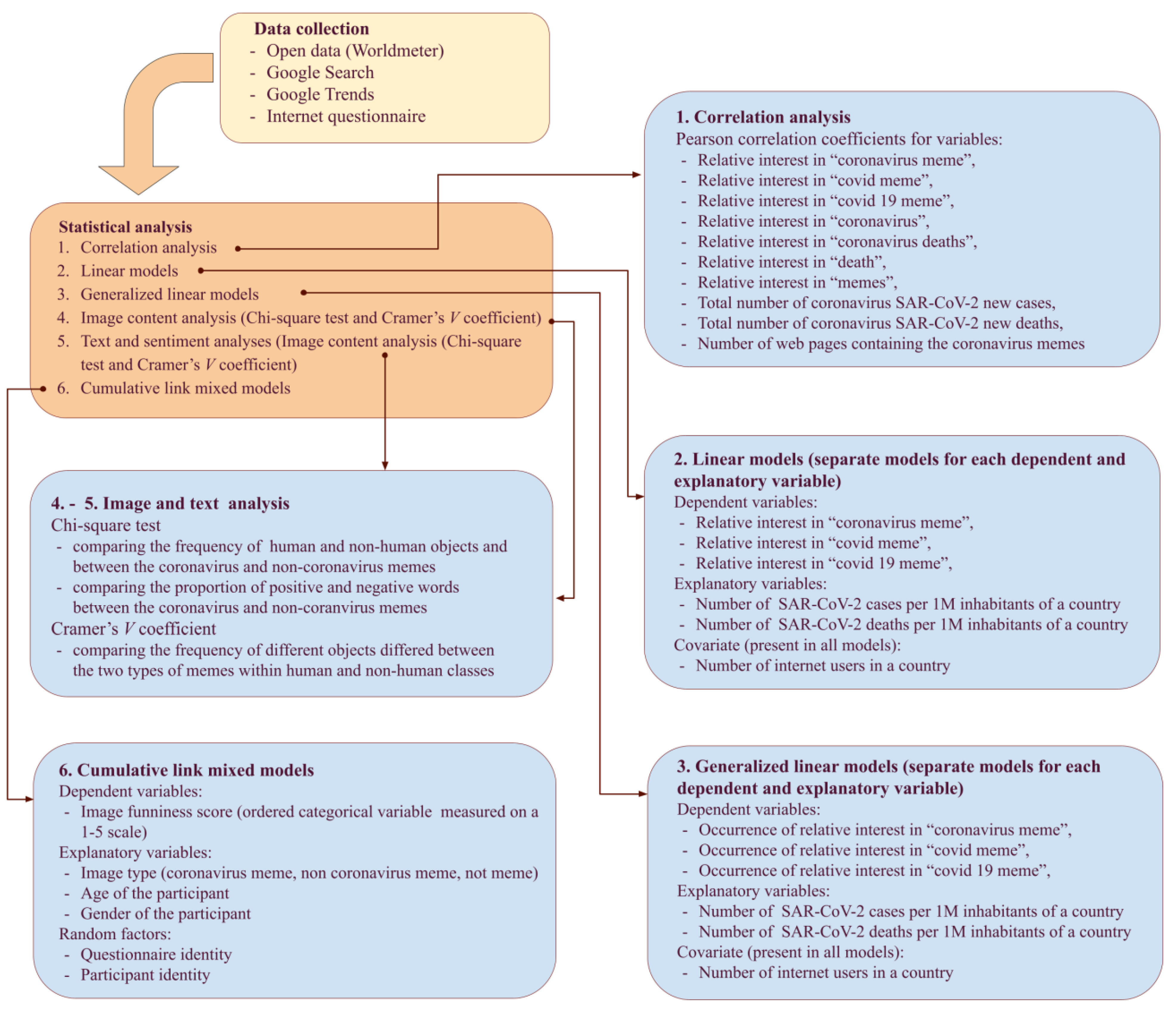
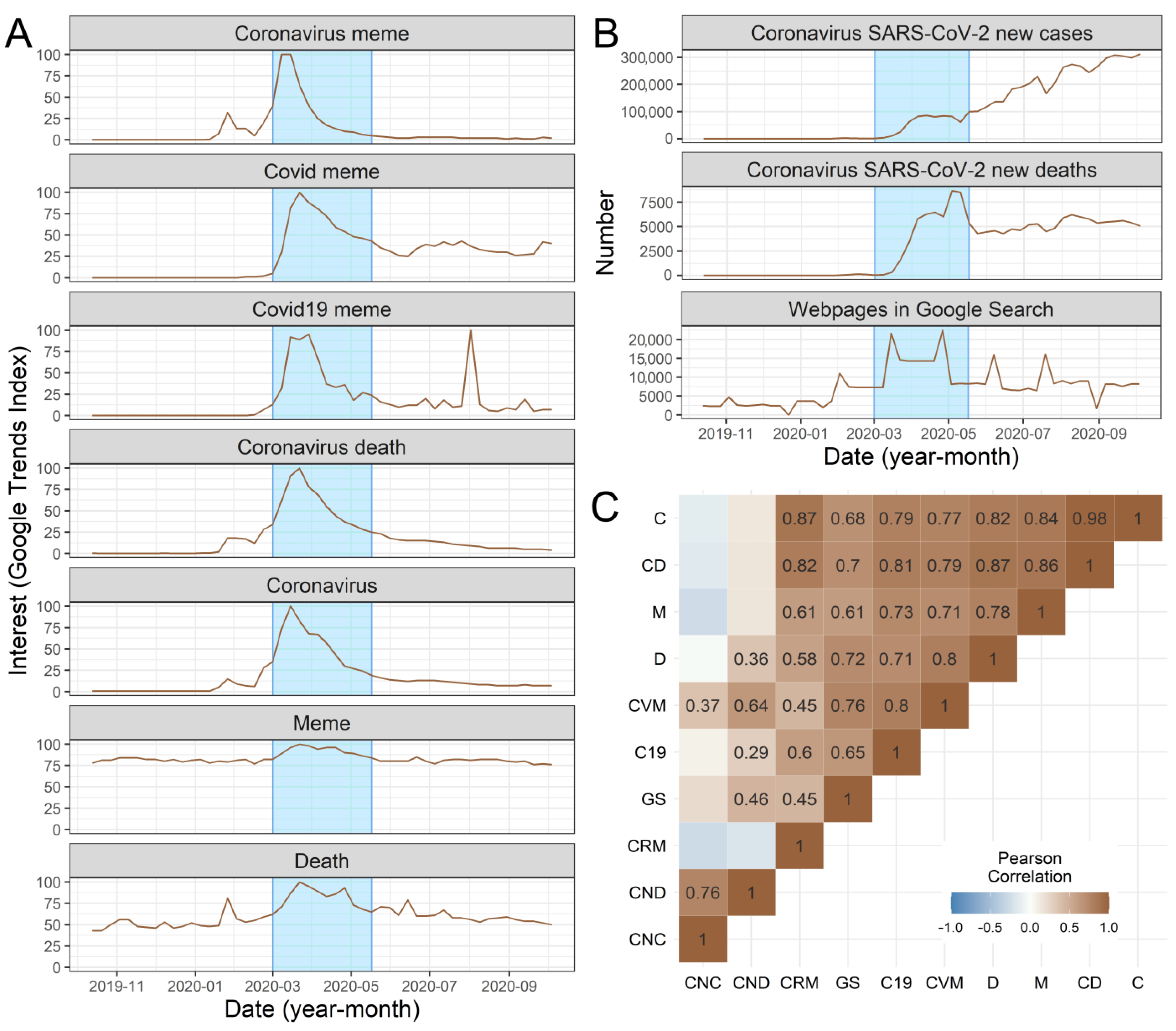
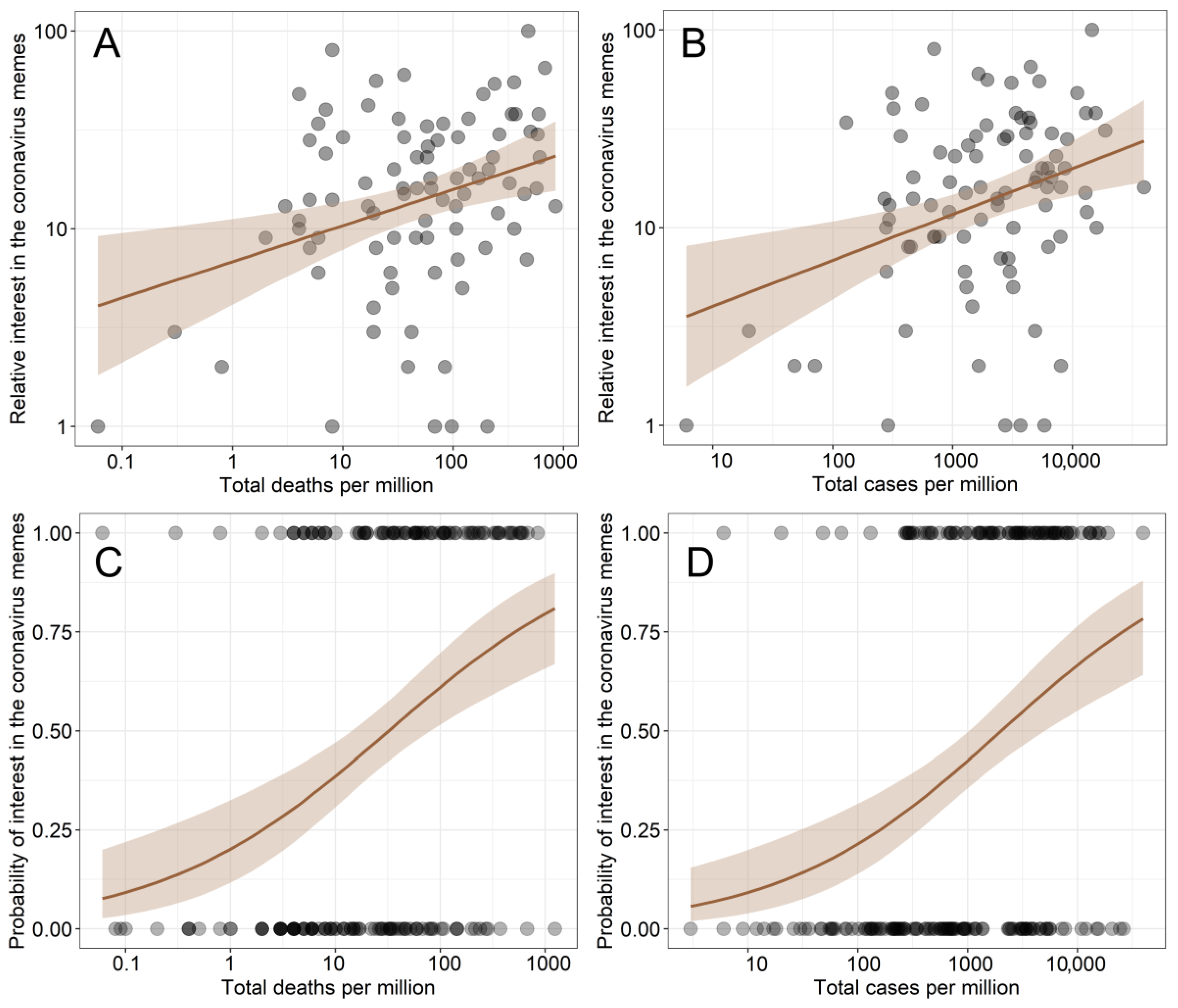
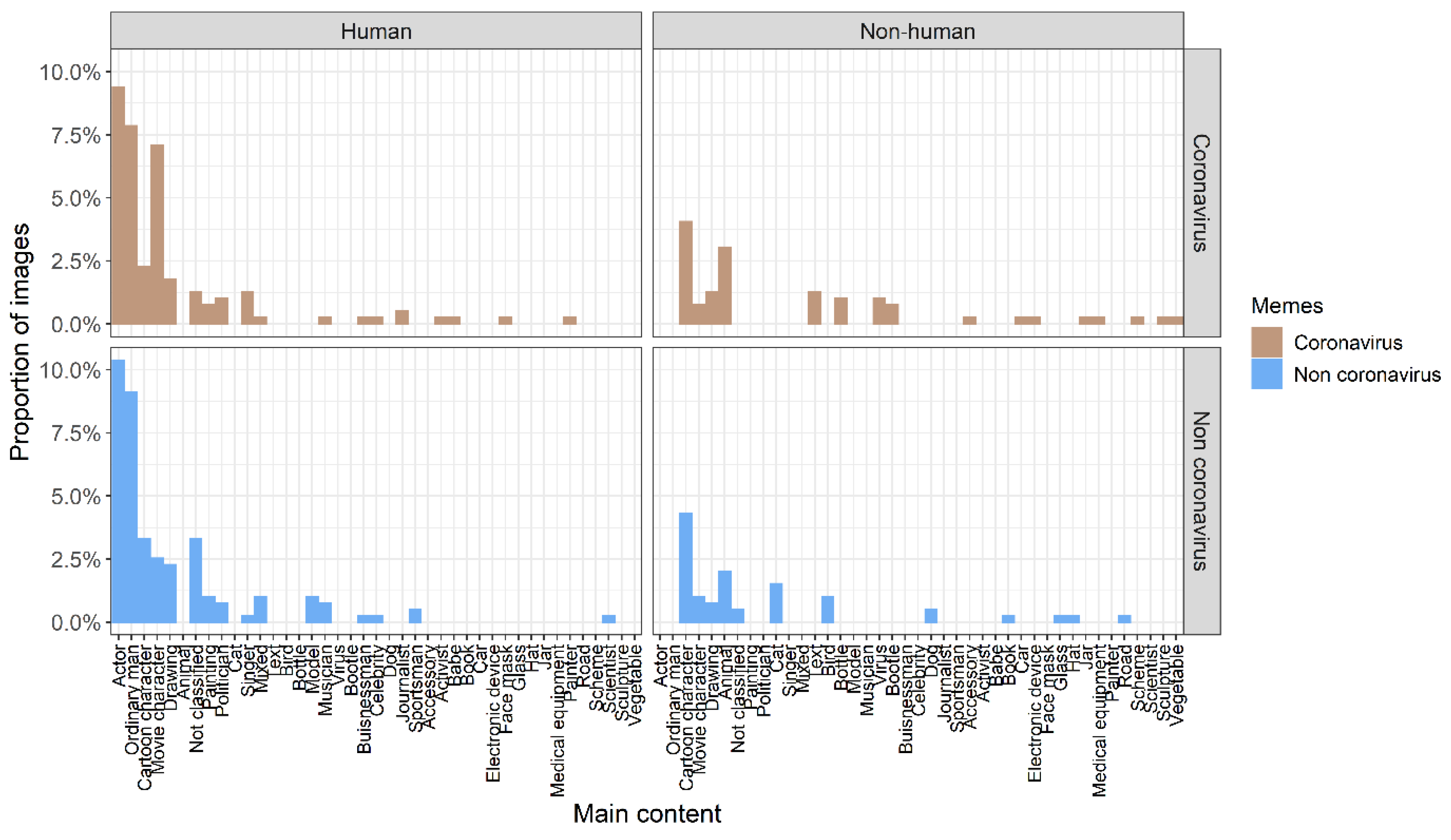
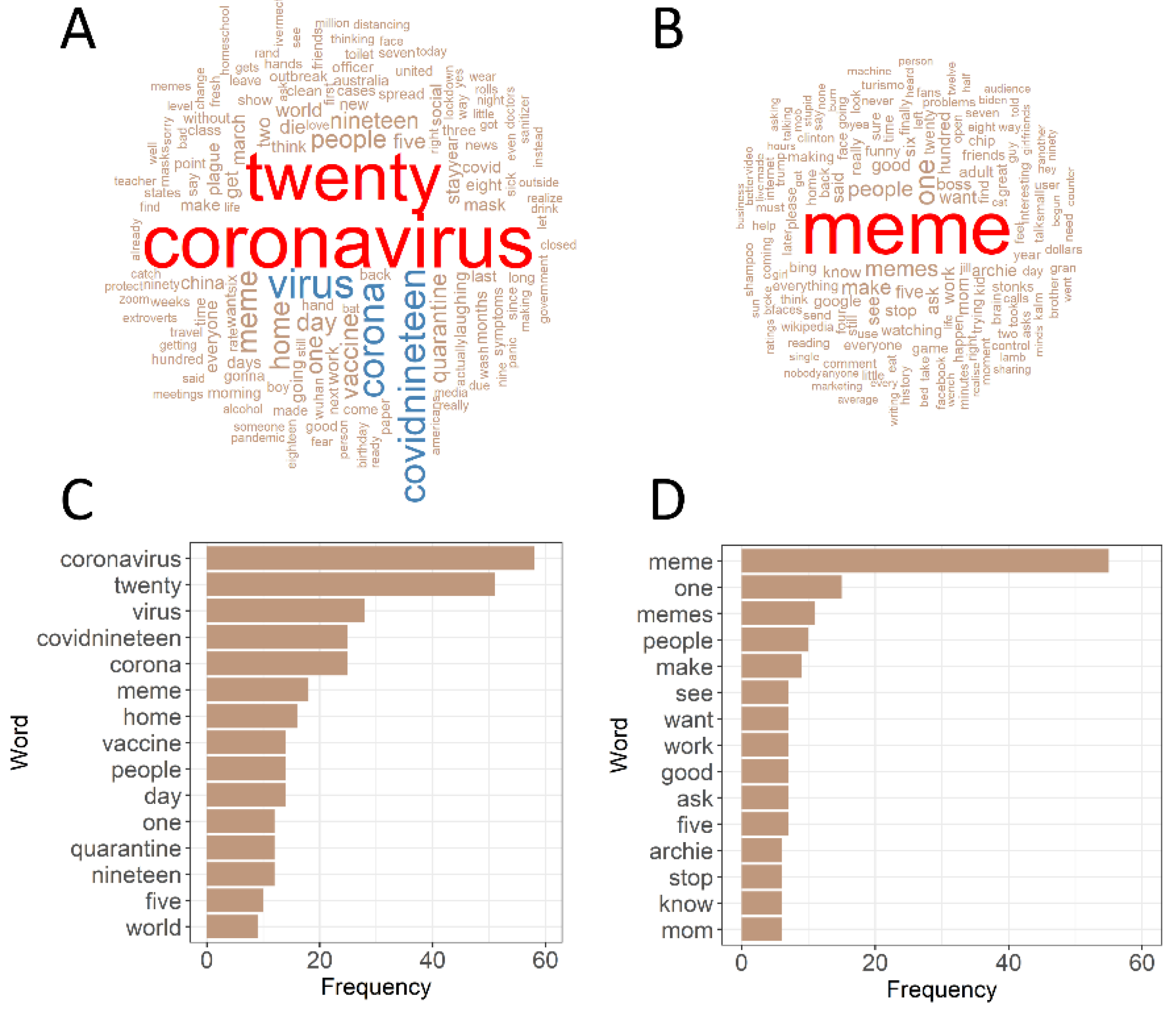
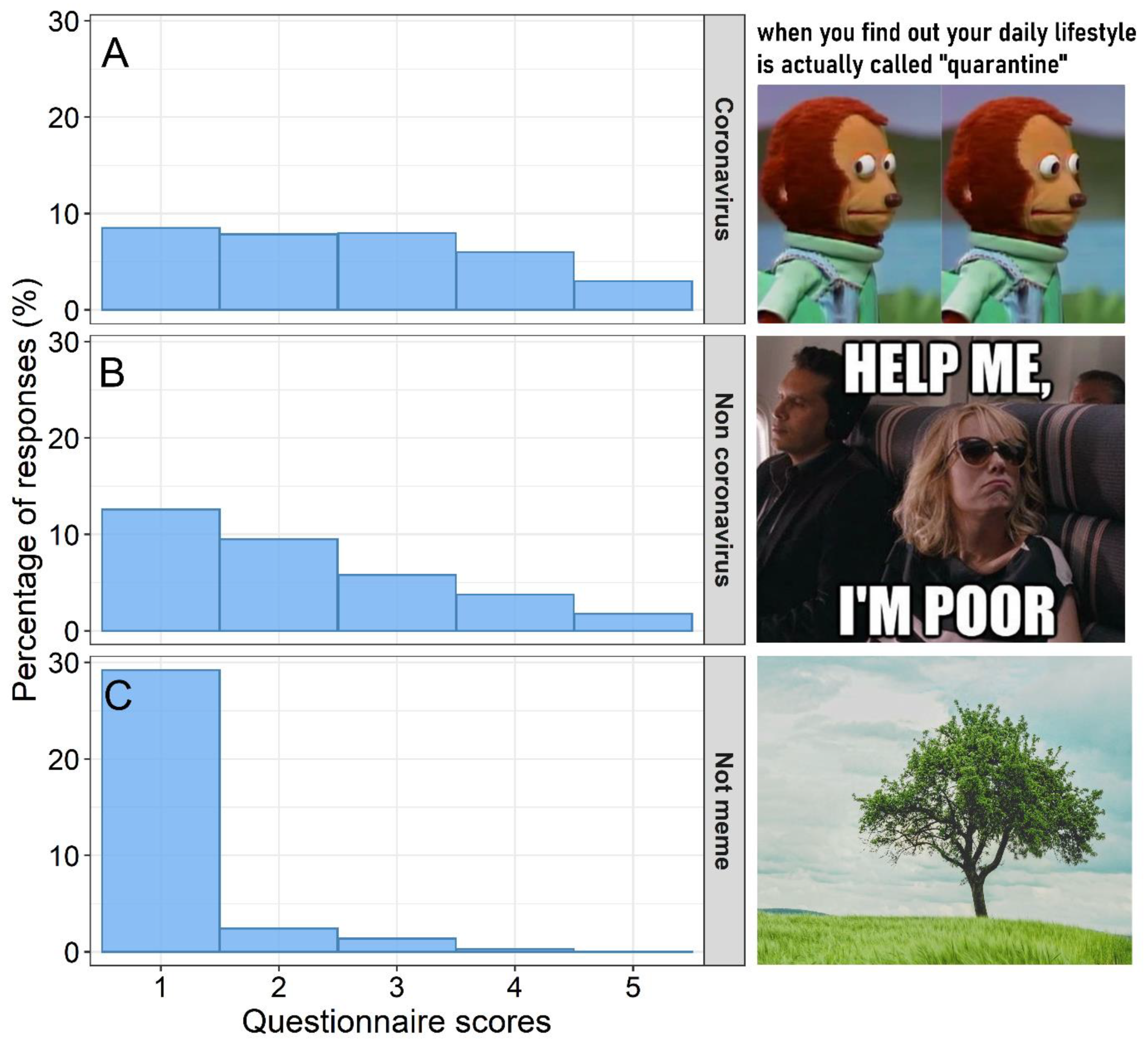
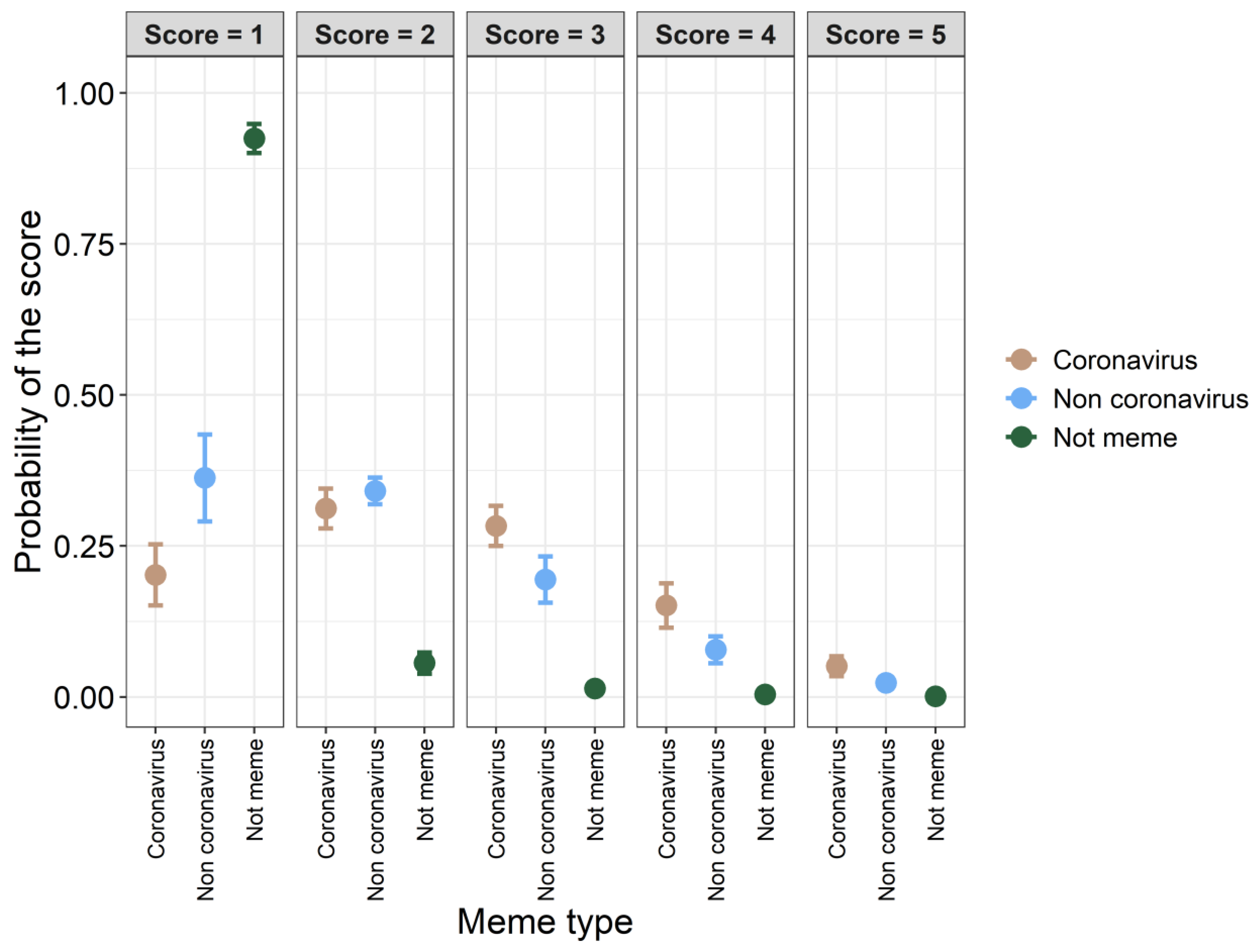
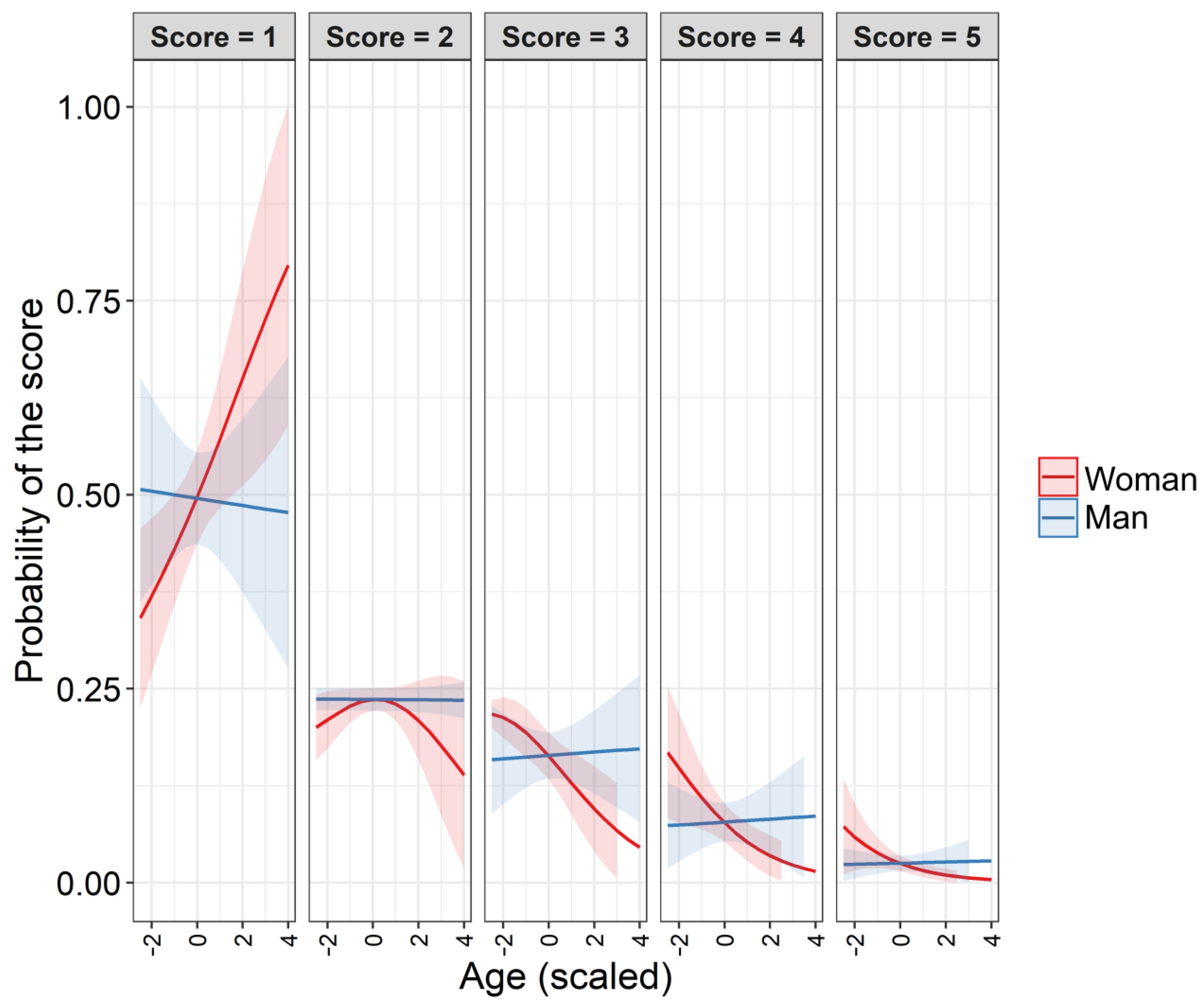
| Variable | Estimate | SE | LL | UL | t(87) | p |
|---|---|---|---|---|---|---|
| (Intercept) | 2.998 | 0.390 | 2.221 | 3.774 | 7.676 | <0.001 |
| Number of deaths per 1M inhabitants of a country (log10 transformed) | 0.220 | 0.051 | 0.118 | 0.322 | 4.301 | <0.001 |
| Number of internet users in a country (log10 transformed) | −0.319 | 0.056 | −0.430 | −0.208 | −5.708 | <0.001 |
| Variable | Estimate | SE | LL | UL | t(86) | p |
|---|---|---|---|---|---|---|
| (Intercept) | 5.047 | 1.018 | 3.024 | 7.070 | 4.959 | <0.001 |
| Number of COVID-19 cases per 1M inhabitants of a country (log10 transformed) | 0.573 | 0.145 | 0.285 | 0.861 | 3.954 | <0.001 |
| Number of internet users in a country (log10 transformed) | −0.619 | 0.132 | −0.882 | −0.356 | −4.675 | <0.001 |
| Variable | OR | LL | UL | z(186) | p |
|---|---|---|---|---|---|
| (Intercept) | 0.00005 | 0.0004 | <0.0001 | −6.695 | <0.001 |
| Number of deaths per 1M inhabitants of a country (log10 transformed) | 3.431 | 2.142 | 5.830 | 4.852 | <0.001 |
| Number of internet users in a country (log10 transformed) | 5.082 | 3.153 | 8.873 | 6.193 | <0.001 |
| Variable | OR | LL | UL | z(209) | p |
|---|---|---|---|---|---|
| (Intercept) | <0.0001 | <0.0001 | 0.0000 | −7.499 | <0.001 |
| Number of COVID-19 cases per 1M inhabitants of a country (log10 transformed) | 3.623 | 2.244 | 6.192 | 4.999 | <0.001 |
| Number of internet users in a country (log10 transformed) | 2.056 | 1.689 | 2.588 | 6.645 | <0.001 |
| Gender | Mean | SD | Minimum | Maximum | N |
|---|---|---|---|---|---|
| Women | 34.8 | 8.44 | 18 | 67 | 63 |
| Men | 35.8 | 8.68 | 18 | 61 | 65 |
| Not specified | 32.3 | 6.81 | 27 | 40 | 3 |
| Variable | OR | LL | UL | z(11) | P |
|---|---|---|---|---|---|
| Threshold coefficients: | |||||
| 1|2 | 0.255 | 0.172 | 0.378 | −6.762 | <0.001 |
| 2|3 | 1.066 | 0.720 | 1.579 | 0.320 | 0.749 |
| 3|4 | 3.965 | 2.668 | 5.891 | 6.818 | <0.001 |
| 4|5 | 18.743 | 12.374 | 28.391 | 13.833 | <0.001 |
| Fixed effects: | |||||
| Meme = Non coronavirus | 0.445 | 0.384 | 0.516 | −10.738 | <0.001 |
| Meme = Not meme | 0.021 | 0.016 | 0.026 | −33.059 | <0.001 |
| Age | 0.631 | 0.442 | 0.899 | −2.550 | 0.011 |
| Gender = Man | 1.015 | 0.631 | 1.633 | 0.060 | 0.952 |
| Age × Gender = Man | 1.634 | 1.010 | 2.644 | 2.001 | 0.045 |
Publisher’s Note: MDPI stays neutral with regard to jurisdictional claims in published maps and institutional affiliations. |
© 2022 by the authors. Licensee MDPI, Basel, Switzerland. This article is an open access article distributed under the terms and conditions of the Creative Commons Attribution (CC BY) license (https://creativecommons.org/licenses/by/4.0/).
Share and Cite
Skórka, P.; Grzywacz, B.; Moroń, D.; Lenda, M. COVID-19 in Memes: The Adaptive Response of Societies to the Pandemic? Int. J. Environ. Res. Public Health 2022, 19, 12969. https://doi.org/10.3390/ijerph191912969
Skórka P, Grzywacz B, Moroń D, Lenda M. COVID-19 in Memes: The Adaptive Response of Societies to the Pandemic? International Journal of Environmental Research and Public Health. 2022; 19(19):12969. https://doi.org/10.3390/ijerph191912969
Chicago/Turabian StyleSkórka, Piotr, Beata Grzywacz, Dawid Moroń, and Magdalena Lenda. 2022. "COVID-19 in Memes: The Adaptive Response of Societies to the Pandemic?" International Journal of Environmental Research and Public Health 19, no. 19: 12969. https://doi.org/10.3390/ijerph191912969
APA StyleSkórka, P., Grzywacz, B., Moroń, D., & Lenda, M. (2022). COVID-19 in Memes: The Adaptive Response of Societies to the Pandemic? International Journal of Environmental Research and Public Health, 19(19), 12969. https://doi.org/10.3390/ijerph191912969






